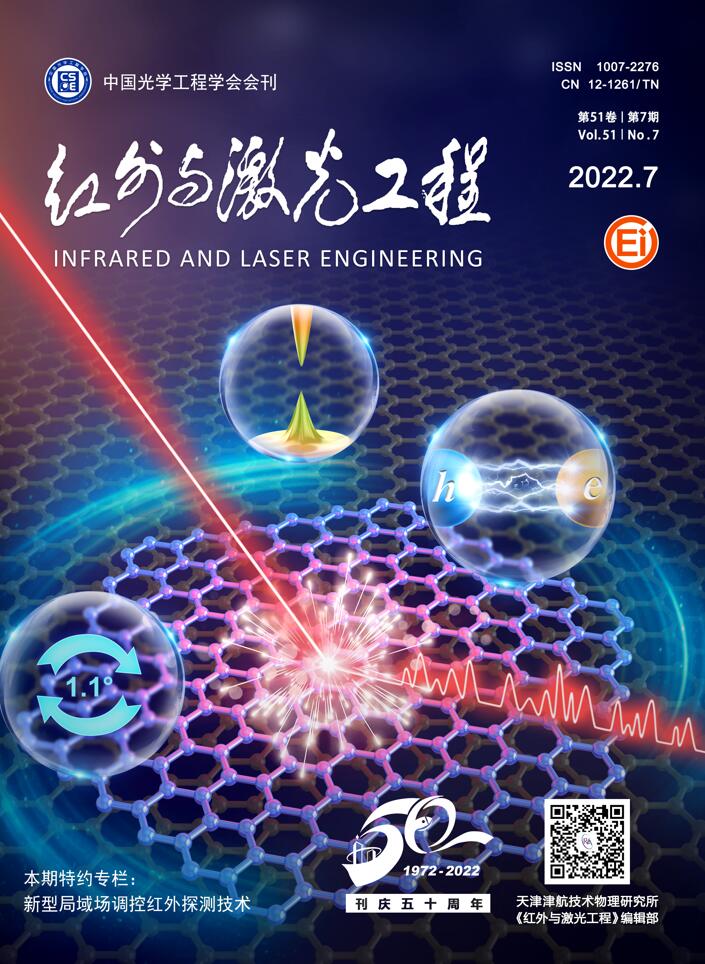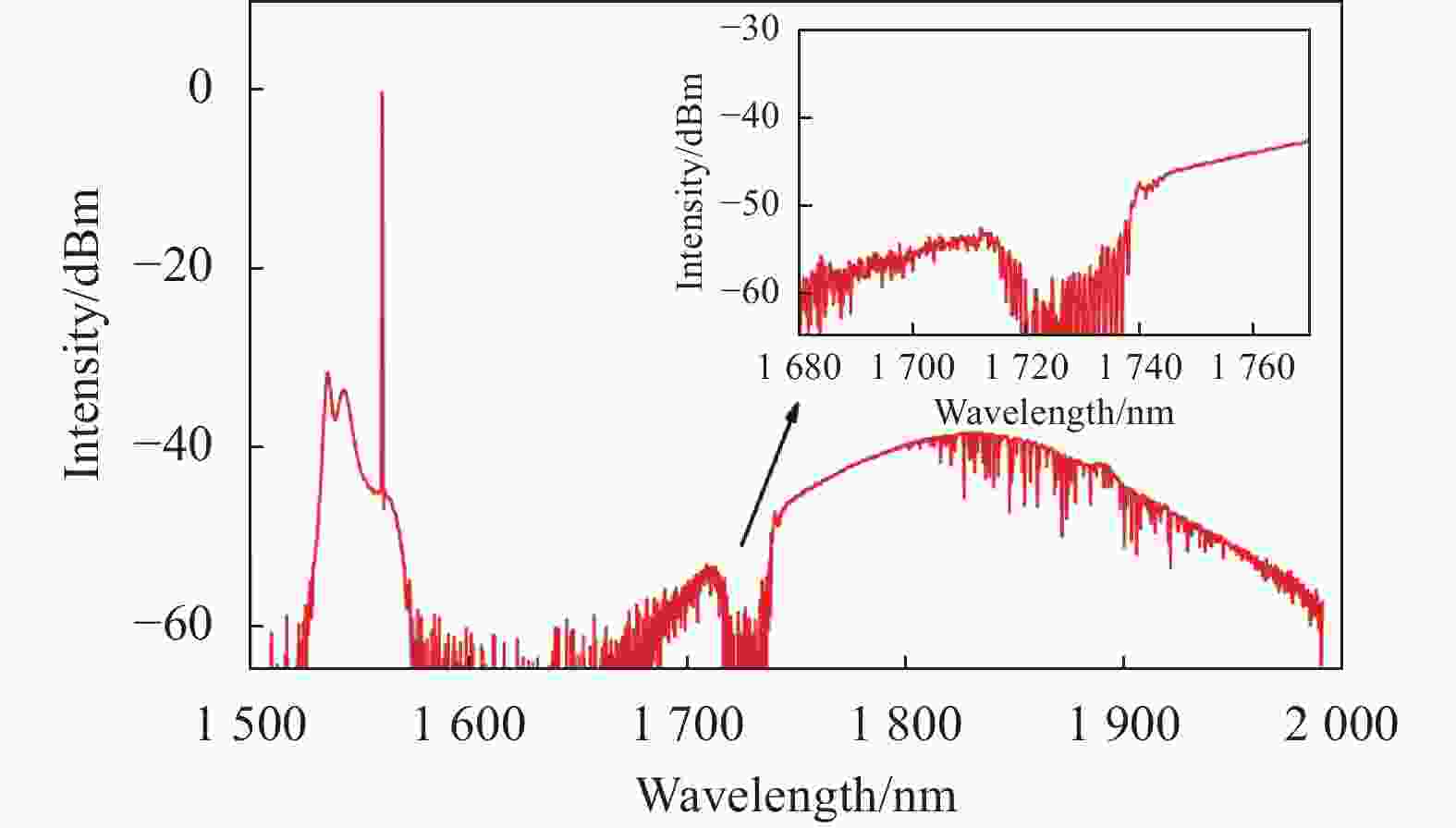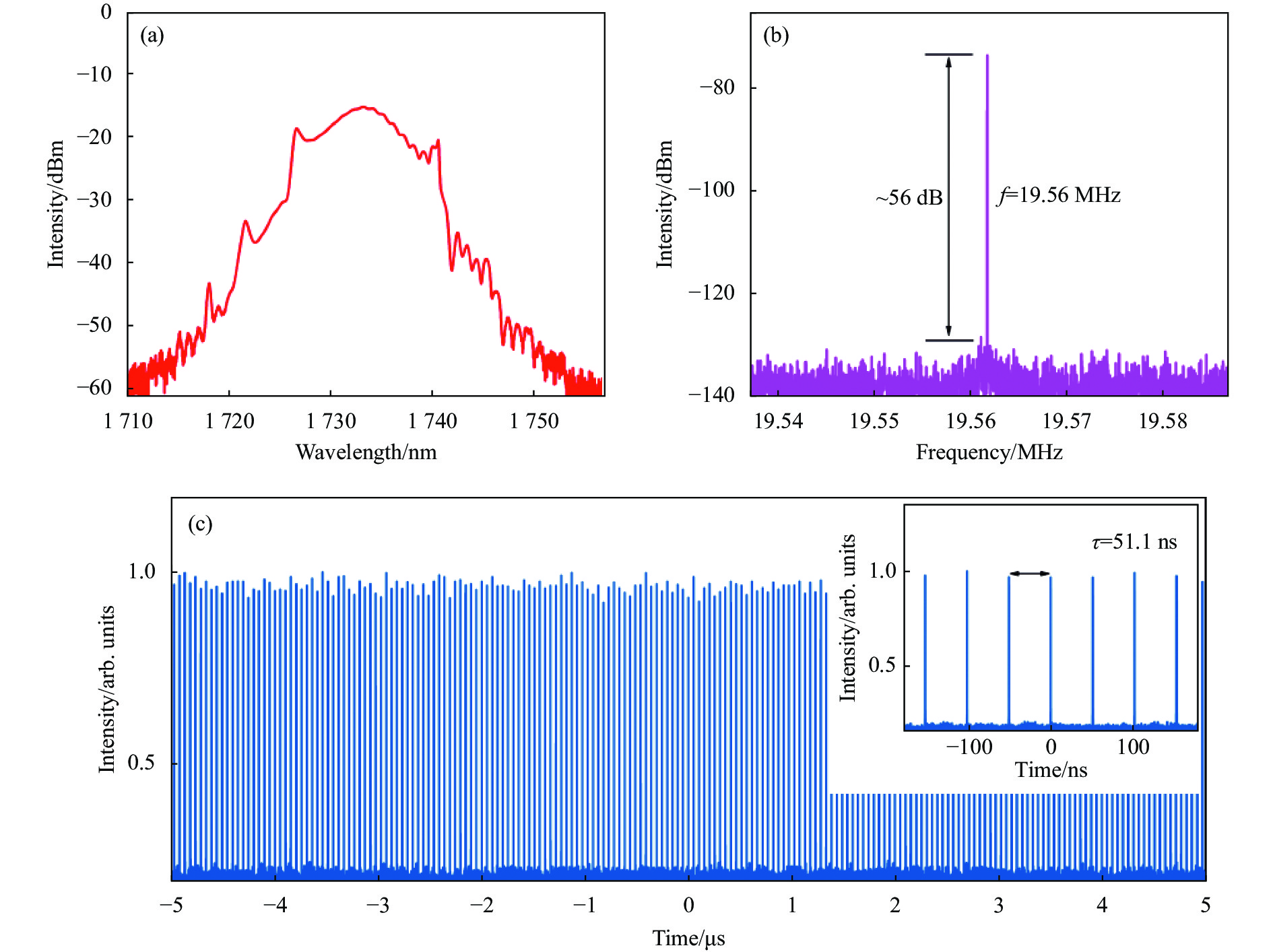-
超快光纤激光器具有光束质量好、易集成以及稳定性好等多种优点,已经被广泛应用于科学研究和工业应用领域中[1-3]。光纤激光器技术的发展极大地推动了相关科学领域的研究。一般来说,不同应用领域对于光纤激光器的性能指标有不同要求。其中,工作波段作为激光器的重要输出指标之一[4],决定了激光器的实际应用范围。近年来,1.7 μm波段的超短脉冲激光由于其独特的光谱特性受到了研究人员的广泛关注。相比于传统的成像窗口,1.7 μm波段超快激光光源在生物组织内具有更小的散射和较低的水吸收[5-6]。因此,1.7 μm波段的超快光源可以在生物成像中实现更大的成像深度,例如多光子显微成像、相干断层成像等[7-8]。另一方面,脂肪以及C-H、O-H等共价键的高吸收峰窗口也位于1.7 μm波段,因此1.7 μm波段的激光源还可以应用于脂肪组织的光声成像、皮脂腺激光手术和聚合物加工与检测中[9-10]。
对1.7 μm波段超快激光光源的巨大需求促使科学家们提出了各种解决方案来获得1.7 μm波段的超快光源[11]。由于1.7 μm处于稀土离子光纤的非典型发射波段,因此,研究人员首先提出利用孤子自频移(Soliton self-frequency shift,SSFS)方法获得的1.7 μm波段超短脉冲光源[12]。虽然SSFS方法不受增益带宽的限制,可以灵活地获得不同波长的脉冲,然而,利用SSFS获得的脉冲在光纤中的频移量与泵浦脉冲峰值功率有关。如需进一步提升1.7 μm波段脉冲功率通常需要使用大纤芯的棒状光子晶体光纤,这无疑会增加系统的复杂度,限制了其应用范围。除了利用非线性波长转换的方法[13],寻找合适的增益光纤来提供1.7 μm波段增益是更为直接有效的方式。俄罗斯科学院的研究人员报道的掺铋光纤(Bismuth-doped fiber,BDF)可以直接获得1.7 μm波段增益[14-15]。然而,目前BDF在1.7 μm波段的增益系数较低,而且并未实现商业化应用。
相比于掺铋光纤,商业化的掺铥光纤在3F4-3H6能级之间具有1600~2100 nm的宽发射谱[16-17],被证明是实现1.7 µm激光的有效增益介质[18-19]。通过在激光腔中加入带通滤波装置,锁模掺铥光纤激光器可以有效输出1.7 µm波段的超短脉冲。基于商用掺铥光纤,研究人员报道了不同性能参数的1.7 µm锁模掺铥光纤激光器。然而这些激光器几乎都包含空间光滤波器件,例如声光滤波器[20]、二向色镜[21]、带通滤光片[22]等。这些空间光的装置无疑会降低激光器的稳定性和集成度。从实际应用角度考虑,全光纤结构的1.7 µm锁模激光器将会是更好的选择。最近,南洋理工大学的Chen等人研制出具有正常色散的掺铥光纤,并通过弯曲TDF产生的滤波效应从而直接搭建1.7 µm的全光纤锁模激光器[23]。然而,该正常色散掺铥光纤需要复杂的预处理,同时没有实现商用。此外,通过弯曲光纤产生的滤波效应也在一定程度上降低了超快光纤激光器的可靠性。
文中报道了一种基于光纤带通滤波器的1.7 µm全光纤掺铥锁模激光器。实验中,通过在激光器内加入光纤带通滤波器有效地过滤了长波放大自发辐射(Amplified spontaneous emission,ASE)光。利用非线性偏振旋转(Nonlinear polarization rotation,NPR)技术实现激光器的锁模,最终获得了中心波长为1733 nm,3 dB带宽为6.3 nm的锁模脉冲输出。除此之外,笔者还数值模拟研究了脉冲在激光器内的演化过程。笔者相信,文中研制的1.7 μm全光纤掺铥锁模激光器,不仅可以进一步提升1.7 μm超快激光源的集成度和稳定性,而且能够为1.7 µm超快光纤激光器的设计提供参考,有望在生物成像、聚合物加工等领域获得重要应用。
-
图1是实验搭建的1.7 μm全光纤掺铥锁模激光器装置示意图。激光器增益介质是一段1 m长的单模掺铥光纤(TmDF200,OFS)。通过优化掺铥光纤的长度来减少信号光的重吸收效应。实验采用中心波长为1560 nm的单模掺铒光纤激光器(Erbium-doped fiber laser,EDFL)作为泵浦源,并通过1560 nm/1750 nm的波分复用器(Wavelength division multiplexer,WDM)对掺铥光纤进行纤芯泵浦。由于掺铥光纤在1.7 μm波段表现为准三能级系统特性,使用纤芯泵浦的方式有利于在掺铥光纤中实现高粒子数反转,从而有效获得短波长增益。除此之外,笔者在激光器内加入了自主设计和定制的光纤滤波器(中心波长:1734 nm,3 dB带宽:25 nm)来抑制长波长的放大自发辐射光,使激光器在1.7 μm波段激射。该三端口滤波器的反射端口会将激光器内残余泵浦光和ASE输出,来防止器件过热造成的损坏。激光腔内偏振相关隔离器(Polari-zation-dependent isolator,PD-ISO)在确保激光单向运转的同时,还能够作为起偏器。偏振控制器(Polari-zation controller,PC)主要用于调整腔内激光的偏振状态。最后,脉冲通过光纤耦合器(Optical coupler,OC)的80%端口输出。激光器内光纤器件尾纤均为SMF-28 e,腔长为10.5 m,其中单模光纤长度为9.5 m,通过计算可知激光器腔内的净色散约为−0.4525 ps2。激光器输出光谱和脉冲由光谱仪(Yokogawa,AQ6375 B)和带有光电探测器(New Focus P818-BB-35 F,12.5 GHz)的高速实时示波器(Tektronix,DSA71604 B,16 GHz)测量。
-
基于NPR的可饱和吸收效应与激光器内的偏振状态和泵浦功率水平有关[24]。因此,在340 mW的泵浦功率条件下,通过调节激光腔内PC的旋转角度,激光器实现了单脉冲状态运行。如图2(a)所示,锁模脉冲光谱在中心波长两侧具有典型的Kelly边带[25],为孤子锁模的典型特征。锁模光谱的中心波长为1733 nm,3 dB带宽为6.3 nm,对应于501 fs的变换极限脉冲(双曲正割型)。由于NPR锁模光纤激光器中的Lyot滤波效应,通过调节PC激光器输出的中心波长可以在小范围内调谐。图2(c)是测量的脉冲序列,脉冲重复频率为19.56 MHz对应于51.1 ns的脉冲间隔。激光器的输出功率为1.4 mW,通过计算可知获得的单脉冲能量约为72 pJ。这里脉冲输出的能量受到孤子面积定理的限制,进一步升高泵浦功率会导致脉冲分裂,并形成多脉冲。图2(b)是脉冲的射频谱图,频率峰值位于19.56 MHz,这与激光器的基本重复频率一致。此外,射频谱信号表明激光脉冲输出的信噪比约为55 dB,证明了激光器工作在稳定单脉冲状态。实验中,由于输出脉冲功率较低,因此无法测量出可以表征脉冲宽度的自相关信号。此外,由于掺铥光纤在长波具有很高的发射截面[16],这导致激光器会在长波产生宽的ASE光。如图3所示,光纤带通滤波器的反射端口输出光谱包括长波ASE光谱,以及未被吸收的1560 nm泵浦光。因此,该结果证明了该光纤带通滤波器有效地过滤了这些光谱成分,从而保证了激光器在1.7 μm波段的稳定运行。
为了进一步研究脉冲在激光器内的传输特性,笔者数值模拟了脉冲在激光器内的演化过程。基于标准的对称分步傅里叶算法,采用非线性薛定谔方程对脉冲演化进行模拟:
式中:A为脉冲的慢变包络振幅;i为虚数单位;变量z和t分别代表了传输距离和时间;β2、g和γ分别代表了群速度色散(GVD)、掺铥光纤增益系数和光纤克尔非线性系数。掺铥光纤的增益系数为:
式中:g0为小信号增益;
${E}_{P}=\displaystyle \int {\left|A\right|}^{2}{\rm d}t$ 是脉冲能量;Es为掺铥光纤的饱和能量,并且可以代表泵浦功率强度。另外,在模拟中掺铥光纤的增益带宽被设置为200 nm。NPR锁模过程可以用强度传递函数来表示:式中:q0代表了调制深度;
$ {\left|A\left(t\right)\right|}^{2} $ 和P0分别为瞬时强度和饱和功率。此外,考虑到激光器的实际参数和光纤位置排布,数值模拟使用了以下参数:g0=3 dBm−1,γ=0.003 W−1 m−1,增益光纤长度和色散分别为LTDF=1 m,β2=−0.025 ps2 m−1,单模光纤长度和色散为LSMF=9.5 m,β2=−0.045 ps2 m−1。调制深度和饱和功率分别为q0=0.5和P0=100 W,耦合输出比例为Rout=80%。数值模拟中超高斯型带通滤波器的中心波长和3 dB带宽分别设置为1734 nm和25 nm。光脉冲在激光器腔中经过多次循环后,最终得到了稳定的输出。
Figure 2. Laser output character. (a) Mode-locked spectrum; (b) Radio frequency spectrum; (c) Pulse train
图4(a)为数值模拟的激光器孤子脉冲输出光谱,其展示出反常色散锁模孤子光纤激光器的典型光谱特征,即光谱中带有明显的Kelly边带。锁模孤子光谱的中心波长为1733.4 nm,3 dB带宽为6.35 nm,对应的输出脉冲宽度为497 fs,如图4(b)所示。通过与图2的实验结果相比较,可以看出数值模拟时域、频域结果与实验相吻合。注意到实验测量孤子脉冲光谱的Kelly边带具有不对称性,因此笔者模拟了脉冲在腔内不同位置的光谱演化来进一步分析边带不对称性,如图4(c)所示。可以看出:由于滤波器对孤子脉冲的整形作用,锁模光谱在经过滤波器时长波部分的边带被滤掉,进而导致了锁模光谱上不对称的Kelly边带[26]。图4(d)展示了锁模光谱的3 dB带宽在腔内演化过程,可以看到锁模孤子光谱带宽具有呼吸行为,这是由于激光腔内不同色散光纤及单元器件对孤子脉宽影响不同而导致的。
-
文中报道了全光纤结构的1.7 μm锁模脉冲掺铥光纤激光器。通过在激光器内加入光纤带通滤波器,同时利用NPR锁模技术,最终获得了1.7 μm波段的超短脉冲输出。激光器输出的锁模脉冲光谱中心波长和3 dB带宽分别为1733 nm和6.3 nm。此外,基于锁模光纤激光器的实际结构参数,数值模拟了光纤激光器中光脉冲演化,并且得到了与实验数据一致的模拟结果。文中研制的全光纤1.7 μm激光器不仅可以提高1.7 μm脉冲激光的紧凑性与可靠性,而且能够为1.7 μm波段高能量脉冲放大系统提供良好的激光种子源。
Research on a 1.7 μm all-fiber mode-locked Tm-doped fiber laser
doi: 10.3788/IRLA20220234
- Received Date: 2022-04-02
- Rev Recd Date: 2022-05-10
- Publish Date: 2022-08-05
-
Key words:
- ultrafast fiber laser /
- 1.7 μm laser source /
- Tm-doped fiber /
- passive mode-locking /
- ultrashort pulse
Abstract: The 1.7 μm ultrashort pulse fiber laser has received great attention for its promising applications in various fields, such as bioimaging and materials processing. We experimentally built a 1.7 μm all-fiber structure mode-locked Tm-doped fiber laser based on the nonlinear polarization rotation technique. The optical gain at the 1.7 μm waveband is effectively obtained by using a core-pumping scheme, and the ASE at long wavelengths is suppressed by a fiber-based bandpass filter in the cavity. The proposed fiber laser delivers an ultrashort pulse with a central wavelength of 1733 nm and a 3 dB bandwidth of 6.3 nm. The mode-locked pulse has a repetition frequency of 19.56 MHz and an average power of 1.4 mW. In addition, the evolution of the pulse inside the laser cavity is numerically simulated. The proposed 1.7 μm all-fiber mode-locked laser is beneficial to further improve the stability and integration of the 1.7 μm laser source, which could find important applications in fields such as bioimaging.















 DownLoad:
DownLoad:


